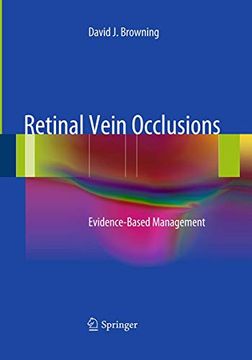Share
Retinal Vein Occlusions: Evidence-Based Management (in English)
David J. Browning (Author)
·
Springer
· Paperback
Retinal Vein Occlusions: Evidence-Based Management (in English) - David J. Browning
$ 236.83
$ 249.99
You save: $ 13.16
Choose the list to add your product or create one New List
✓ Product added successfully to the Wishlist.
Go to My WishlistsIt will be shipped from our warehouse between
Thursday, July 11 and
Friday, July 12.
You will receive it anywhere in United States between 1 and 3 business days after shipment.
Synopsis "Retinal Vein Occlusions: Evidence-Based Management (in English)"
After diabetic retinopathy, the varieties of retinal vein occlusion (central, hemi-central, and branch) constitute the most prevalent category of retinal vascular disease. For macular edema associated with central retinal vein occlusion (CRVO), no effective therapy existed until 2009 despite decades of research and failed pilot therapies. In 2009, serial intravitreal triamcinolone therapy was proven to be effective compared to observation. In 2010, a randomized controlled trial reported that laser anastomosis was associated with improved vision relative to observation. For iris neovascularization associated with CRVO, laser panretinal photocoagulation has been proven to be effective at reducing neovascular glaucoma since 1995 and intraocular anti-VEGF drug injections for short term regression of iris neovascularization since 2005. For macular edema associated with branch retinal vein occlusion (BRVO), grid laser photocoagulation was proven to have modest benefits compared to observation since 1988. Sector panretinal photocoagulation for retinal neovascularization associated with BRVO was proven to be effective in reducing vitreous hemorrhage in 1990.Many proposed surgical therapies including radial optic neurotomy, retinal venous sheathotomy, and vitrectomy with panretinal laser photocoagulation have been piloted and abandoned in the last 20 years because of an excess of adverse side effects or lack of efficacy relative to a treatment benefit. In the past 5 years, intravitreal injections of anti VEGF drugs have been developed and hold out the promise of improved outcomes compared to the older therapies. Concomitant with these treatment advances has been an improved but incomplete understanding of the underlying pathophysiology of retinal vein occlusions.
- 0% (0)
- 0% (0)
- 0% (0)
- 0% (0)
- 0% (0)
All books in our catalog are Original.
The book is written in English.
The binding of this edition is Paperback.
✓ Producto agregado correctamente al carro, Ir a Pagar.

